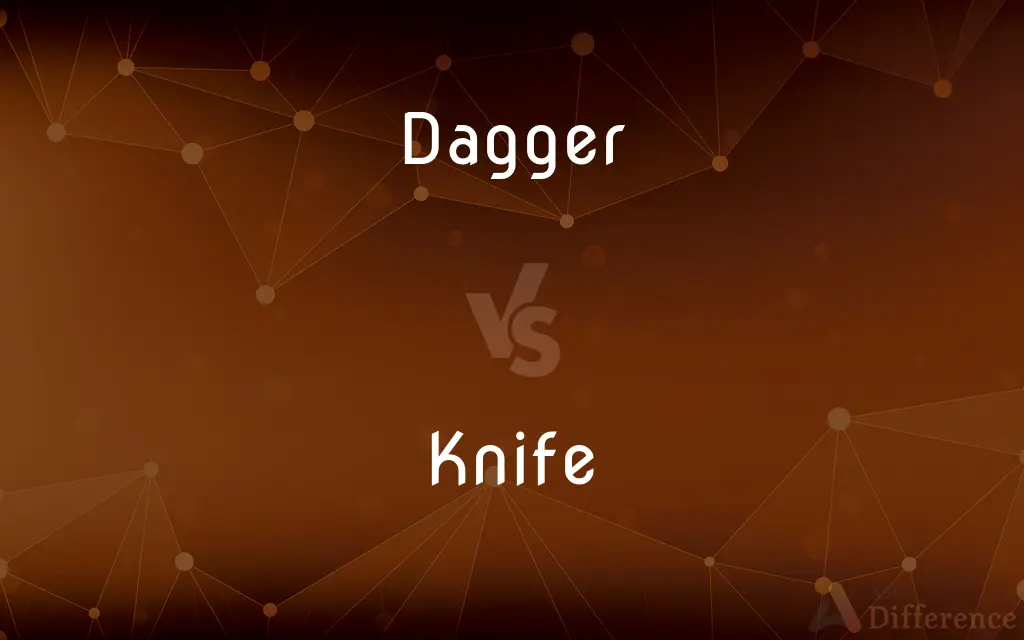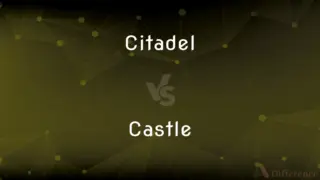Dagger vs. Knife — What's the Difference?
By Fiza Rafique & Urooj Arif — Updated on April 25, 2024
Daggers are designed primarily for stabbing with pointed, double-edged blades; knives serve a broader range of cutting tasks with single-edged blades.

Difference Between Dagger and Knife
Table of Contents
ADVERTISEMENT
Key Differences
A dagger is typically characterized by its sharp, double-edged blade, designed specifically for thrusting and piercing. In contrast, a knife generally features a single-edged blade that is used for slicing, chopping, and other cutting tasks.
Daggers often have a symmetrical design, focusing on balance and the ability to penetrate quickly, whereas knives might have various blade shapes and sizes tailored to specific applications such as cooking, hunting, or crafting.
The handle of a dagger is usually designed to enhance gripping for stabbing motions, while a knife's handle may be designed for comfort and versatility in a range of uses.
Historically, daggers have been used as weapons in close combat, while knives have been essential tools for survival, culinary, and utilitarian purposes.
In modern times, daggers are primarily seen in ceremonial roles or as collectibles, whereas knives are everyday tools across various professions and households.
ADVERTISEMENT
Comparison Chart
Blade Edge
Double-edged, sharp on both sides
Single-edged, sharp on one side
Primary Use
Stabbing and piercing
Cutting, slicing, and chopping
Blade Shape
Symmetrical and pointed
Varied shapes (straight, curved, etc.)
Handle
Designed for grip during thrusting
Designed for comfort and versatile use
Usage
Combat, ceremonial roles, collectibles
Culinary, crafting, survival, everyday use
Compare with Definitions
Dagger
A symbol of stealth and danger, often represented in literature and film.
The dagger in the story symbolized betrayal.
Knife
A tool or weapon with a blade that is sharp on one edge.
She used a knife to chop vegetables for the salad.
Dagger
A short, double-edged blade used mainly in historical or ceremonial contexts.
The museum displayed medieval daggers from Europe.
Knife
An object used in crafts and arts for precise cuts.
The artist used a precision knife to cut the paper for her collage.
Dagger
A knife with a very sharp point designed for stabbing.
The soldier carried a dagger in his boot for close combat.
Knife
A versatile implement used in various culinary tasks.
A chef's knife is essential for preparing meals.
Dagger
A weapon used for quick, piercing strikes in combat.
The assassin pulled out a dagger from beneath his cloak.
Knife
A common household tool for cutting or spreading.
He grabbed a butter knife to spread the jam.
Dagger
A tool for precise and deep penetration.
He used a small dagger to carve the intricate designs into the wood.
Knife
A portable and essential tool for camping and survival.
He always carries a knife when hiking in the woods.
Dagger
A dagger is a knife with a very sharp point and usually two sharp edges, typically designed or capable of being used as a thrusting or stabbing weapon. Daggers have been used throughout human history for close combat confrontations, and many cultures have used adorned daggers in ritual and ceremonial contexts.
Knife
A knife (plural knives; from Old Norse knifr 'knife, dirk') is a tool or weapon with a cutting edge or blade, often attached to a handle or hilt. One of the earliest tools used by humanity, knives appeared at least 2.5 million years ago, as evidenced by the Oldowan tools.
Dagger
A short knife with a pointed and edged blade, used as a weapon
He drew his dagger and stabbed the leader
Knife
A cutting instrument consisting of a sharp blade attached to a handle.
Dagger
A moth with a dark dagger-shaped marking on the forewing.
Knife
A cutting edge; a blade.
Dagger
A short pointed weapon with sharp edges.
Knife
To use a knife on, especially to stab; wound with a knife.
Dagger
Something that agonizes, torments, or wounds.
Knife
(Informal) To betray or attempt to defeat by underhand means.
Dagger
See obelisk.
Knife
To cut or slash a way through something with or as if with a knife
The boat knifed through the waves.
Dagger
A double dagger.
Knife
A utensil or a tool designed for cutting, consisting of a flat piece of hard material, usually steel or other metal (the blade), usually sharpened on one edge, attached to a handle. The blade may be pointed for piercing.
Dagger
(weapons) A stabbing weapon, similar to a sword but with a short, double-edged blade.
Knife
A weapon designed with the aforementioned specifications intended for slashing and/or stabbing and too short to be called a sword. A dagger.
Dagger
(typography) The text character †; the obelus.
Knife
Any blade-like part in a tool or a machine designed for cutting, such as that of a chipper.
Dagger
A point scored near the end of the game (clutch time) to take or increase the scorer's team lead, so that they are likely to win.
Curry's last-minute 3-point dagger silenced the criticism for his so-called failure to come up big in big moments.
Knife
(transitive) To cut with a knife.
Dagger
A timber placed diagonally in a ship's frame.
Knife
(intransitive) To cut through as if with a knife.
The boat knifed through the water.
Dagger
To pierce with a dagger; to stab.
Knife
(transitive) To betray, especially in the context of a political slate.
Dagger
A short weapon used for stabbing. This is the general term: cf. Poniard, Stiletto, Bowie knife, Dirk, Misericorde, Anlace.
Knife
(transitive) To positively ignore, especially in order to denigrate; compare cut.
Dagger
A mark of reference in the form of a dagger [
Knife
An instrument consisting of a thin blade, usually of steel and having a sharp edge for cutting, fastened to a handle, but of many different forms and names for different uses; as, table knife, drawing knife, putty knife, pallet knife, pocketknife, penknife, chopping knife, etc..
Dagger
A timber placed diagonally in a ship's frame.
Knife
A sword or dagger.
The coward conquest of a wretch's knife.
Dagger
To pierce with a dagger; to stab.
Knife
To prune with the knife.
Dagger
A short knife with a pointed blade used for piercing or stabbing
Knife
To cut or stab with a knife.
Dagger
A character used in printing to indicate a cross reference or footnote
Knife
Fig.: To stab in the back; to try to defeat by underhand means, esp. in politics; to vote or work secretly against (a candidate of one's own party).
Knife
Edge tool used as a cutting instrument; has a pointed blade with a sharp edge and a handle
Knife
A weapon with a handle and blade with a sharp point
Knife
Any long thin projection that is transient;
Tongues of flame licked at the walls
Rifles exploded quick knives of fire into the dark
Knife
Use a knife on;
The victim was knifed to death
Common Curiosities
What are common uses of knives?
Knives are used for a wide range of tasks, including cooking, hunting, crafting, and everyday utility.
Can a dagger be used for general cutting tasks like a knife?
While possible, daggers are not ideal for general cutting due to their double-edged design.
How do the handles of daggers and knives differ?
Dagger handles are designed to secure the hand during thrusting motions, while knife handles prioritize comfort and control for varied tasks.
Are daggers legal to carry in public?
In many places, carrying daggers openly or concealed in public is restricted or illegal.
What is the historical significance of daggers?
Daggers have been used historically as weapons in battle and as symbols of power and treachery.
Can a knife be used as a weapon like a dagger?
Yes, though knives are more commonly tools, they can be used as weapons if necessary.
What types of materials are used to make dagger and knife blades?
Both are commonly made from metals like steel, but the quality and treatment of the metal can vary widely.
What is the main purpose of a dagger?
A dagger is primarily designed for stabbing, used in combat and self-defense.
How do blade shapes vary between daggers and knives?
Daggers typically have symmetrical, pointed blades, whereas knife blades can vary greatly in shape and size depending on their intended use.
Is there a cultural significance to knives in certain societies?
Yes, knives hold significant cultural value in certain societies.
Share Your Discovery

Previous Comparison
Swab vs. Swap
Next Comparison
Citadel vs. CastleAuthor Spotlight
Written by
Fiza RafiqueFiza Rafique is a skilled content writer at AskDifference.com, where she meticulously refines and enhances written pieces. Drawing from her vast editorial expertise, Fiza ensures clarity, accuracy, and precision in every article. Passionate about language, she continually seeks to elevate the quality of content for readers worldwide.
Co-written by
Urooj ArifUrooj is a skilled content writer at Ask Difference, known for her exceptional ability to simplify complex topics into engaging and informative content. With a passion for research and a flair for clear, concise writing, she consistently delivers articles that resonate with our diverse audience.
















































